

William Stopford
2026 Toyota RAV4: Local lineup detailed for hybrid, PHEV mid-size SUV
14 Hours Ago
When it was first launched in 1994, the original Toyota RAV4 broke new ground by being a go-anywhere, compact 4x4 off-roader with five doors and more creature comforts than anything previously produced by Suzuki. Over five generations, the RAV4 has grown in size and popularity to become Australia's favourite mid-size SUV and one of the nation's five best-selling models, thanks to its family-friendliness and hybrid efficiency.
Quickly see how this car stacks up against its competition. Select any benchmark to see more details.
Where expert car reviews meet expert car buying – CarExpert gives you trusted advice, personalised service and real savings on your next new car.
| Configuration | Price From* |
|---|---|
| 2.5L, Automatic, 5-door SUV, Petrol, 4x4 | $45,260 |
| 2.5L, Automatic, 5-door SUV, Petrol, FWD | $42,260 |
| Configuration | Price From* |
|---|---|
| 2.5L, Automatic, 5-door SUV, Petrol, 4x4 | $48,810 |
| 2.5L, Automatic, 5-door SUV, Petrol, FWD | $45,810 |
| Configuration | Price From* |
|---|---|
| 2.5L, Automatic, 5-door SUV, Petrol, FWD | $48,910 |
| 2.5L, Automatic, 5-door SUV, Petrol, 4x4 | $51,910 |
| Configuration | Price From* |
|---|---|
| 2.5L, Automatic, 5-door SUV, Petrol, 4x4 | $54,410 |
| 2.5L, Automatic, 5-door SUV, Petrol, FWD | $51,410 |
| Configuration | Price From* |
|---|---|
| 2.5L, Automatic, 5-door SUV, Petrol, 4x4 | $58,360 |
Where expert car reviews meet expert car buying – CarExpert gives you trusted advice, personalised service and real savings on your next new car.
See our comprehensive details for the Toyota RAV4
It has either 542L of boot space or 580L, depending on the position of the boot floor. Note this is with the space-saver spare equipped, with no figures available with the full-sized spare offered in the GX.
Where expert car reviews meet expert car buying – CarExpert gives you trusted advice, personalised service and real savings on your next new car.
CarExpert High Resolution Photos of the Toyota RAV4
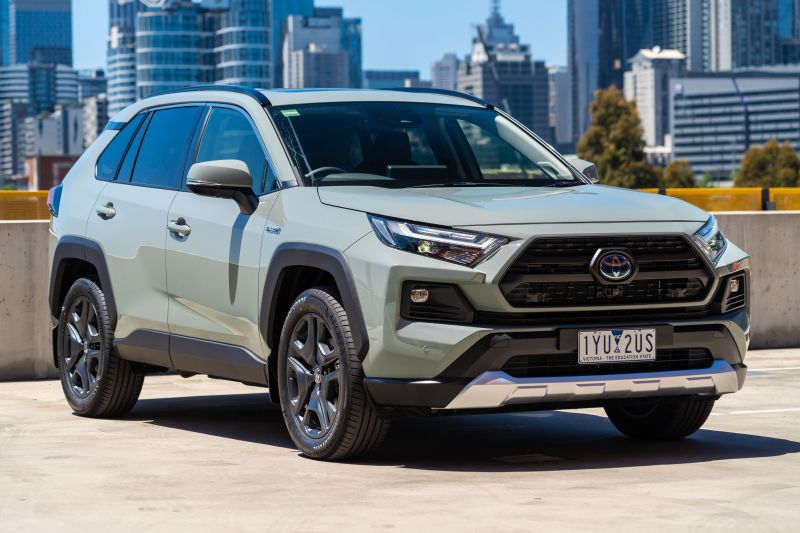
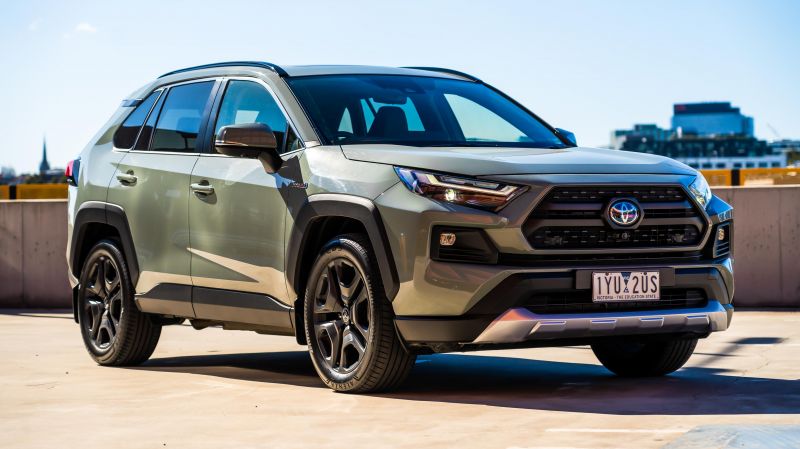

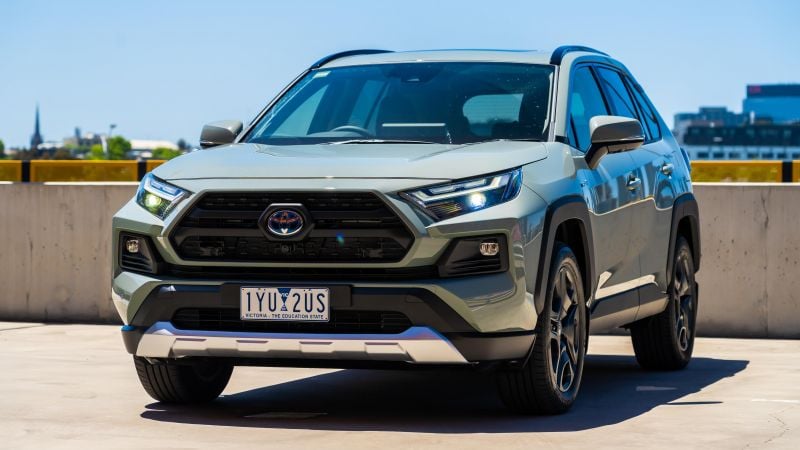
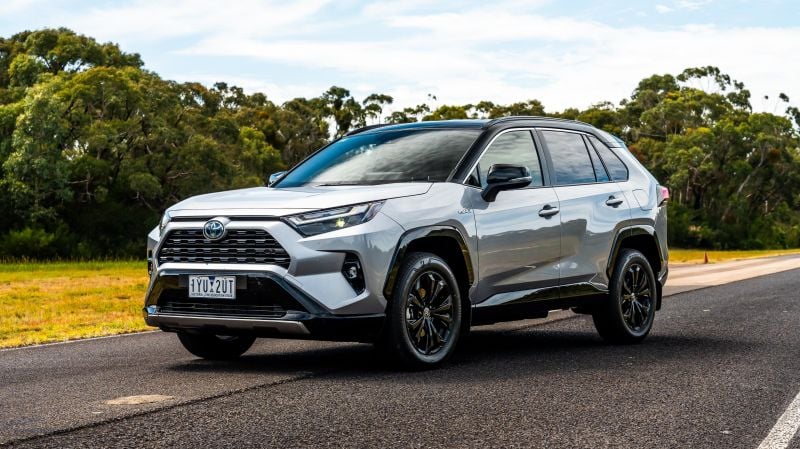
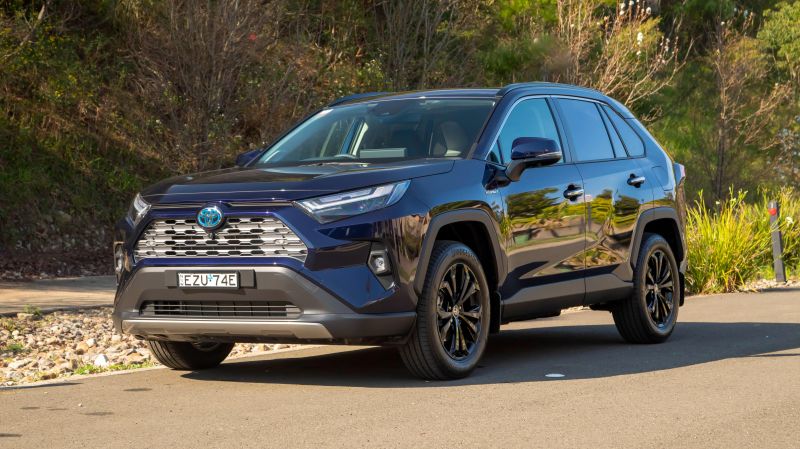
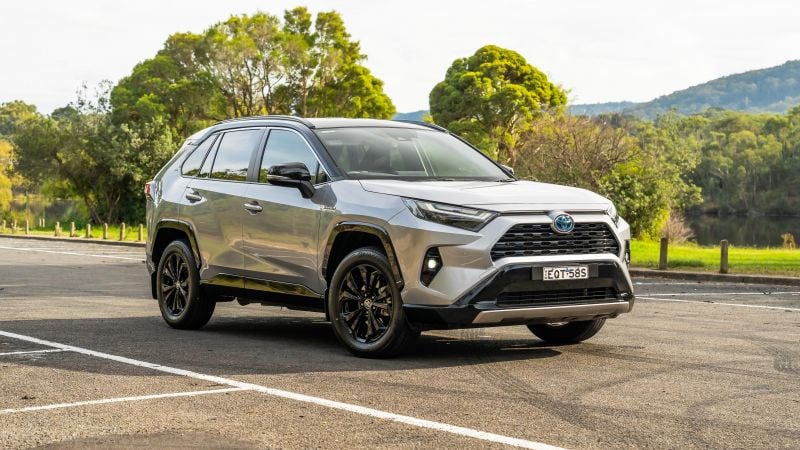
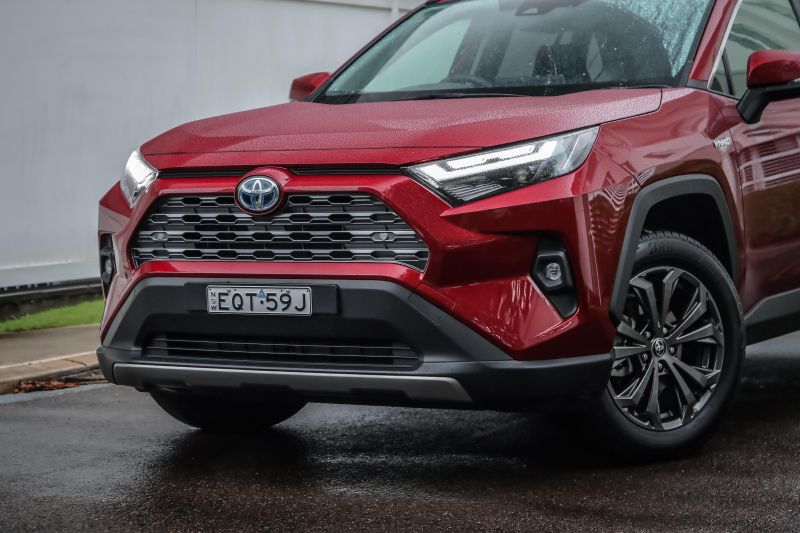
View 25 images
Thanks to its elevated crossover SUV profile, the RAV4 offers convenient ingress and egress. This is particularly beneficial for individuals with limited mobility who may struggle with significant height transitions when entering or exiting a vehicle.
Upon entry, occupants are greeted with faux leather seats, known as SofTex by Toyota, that are soft to the touch but might not hold up well over time; our test model, with only 6000km, already shows creasing on the bolsters.
The driver’s seat provides 10-way electric adjustment, allowing for optimal seating configurations for most people. Substantial thigh support is a notable feature, offering enhanced comfort for those with longer legs.
Lumbar support is also highly adjustable, which is beneficial for those with back issues. Unlike some of the RAV4's competitors, the seat maintains comfort even during long drives.
Both front seats are heated, though the highest setting doesn’t reach a very high temperature. Ventilation is included, providing relief in warmer weather.
A practical feature of the RAV4 is its memory for seat heating and cooling settings from the previous drive, eliminating the need to adjust them each time.
Ahead of the driver is a typical Toyota steering wheel that feels comfortable, although extended use can cause hands to become clammy. Some perforation in the leather would help regulate hand temperature.
Surprisingly, the steering wheel lacks heating, which is unusual given that the Edge is the top variant in the lineup. Many competitors offer this feature, which is highly convenient on cold mornings.
The steering wheel buttons are intuitively placed and provide tactile feedback, making them enjoyable to use.
Behind the wheel, there is a 12.3-inch digital instrument cluster that offers high resolution and a clean layout. While not as configurable as Volkswagen Group’s displays, it does allow some customization of widgets and themes, although most options are restricted once the vehicle is in motion—a common trait among Japanese vehicles.
The mode transitions on the display are visually appealing, featuring animations that depict the RAV4 in different driving scenarios.
Moving to the centre of the dashboard, the 10.5-inch touchscreen infotainment system is a significant improvement over previous Toyota offerings. It boasts ample processing power, quick startup, and responsive touch inputs, which should satisfy users familiar with modern tablets.
The interface is straightforward and user-friendly, with a clear menu structure, though the lack of physical shortcut buttons (aside from a single volume knob) may be less convenient for some users. The volume knob itself is positioned on the driver’s side and lacks tactile feedback when turned.
The RAV4 supports wired and wireless Apple CarPlay, while Android Auto is limited to wired connectivity. During testing, wireless CarPlay with an iPhone 15 Pro Max was reliable, even in areas known for causing connectivity issues.
A wireless phone charger is discreetly placed at the front of the centre console. It effectively charges large devices, though the lack of securing features allows phones to slide off the pad occasionally.
The built-in satellite navigation is user-friendly and connected to the internet, providing live traffic updates and routing information.
Inside the cabin, the RAV4 Edge Hybrid is distinguished by its orange accents, which may not appeal to everyone, but it certainly sets this variant apart. The climate control system features large rubber knobs for temperature adjustment and marked physical buttons for other functions, a refreshing contrast to the trend of integrating these controls into touchscreens.
Higher-spec RAV4 models include a digital rear-view mirror, which seems redundant given the excellent visibility provided by the large windows, unless the boot is fully loaded.
Most primary touchpoints, such as the armrests and dashboard, are soft, though harder plastics are used in lower areas. Softer materials where the legs rest against the centre console would be a welcome improvement.
A notable observation is the flex in some interior components; pressing the centre console from side to side or the climate control unit reveals substantial movement. However, no creaks or rattles were evident during testing, suggesting the flex might be intentional.
The RAV4 provides generous space in the second row for a mid-size SUV, making it a comfortable option for long journeys. Although similarly sized sedans offer more room, the RAV4's large side windows enhance visibility and create a spacious feel.
At 182cm tall, there was ample leg, head, and shoulder room, making the second row a comfortable space for two adults; accommodating three would be slightly cramped but manageable.
Second-row amenities include air vents, USB-C ports, and a fold-down armrest with cupholders. Storage options are limited to a single map pocket and small door pockets.
At the rear, the power tailgate operates slowly and emits a constant beeping sound, which can be inconvenient in busy settings. However, the boot is spacious, offering between 542 and 580 litres with upright seats, making it highly practical.
A retractable cargo cover keeps items hidden but feels somewhat flimsy, which is disappointing for a vehicle in this price range.
Under the boot floor, there is a temporary space-saver spare wheel—a surprising inclusion given that many hybrid SUVs have eliminated spare wheels altogether.
The base model GX comes with
The GXL adds a wireless phone charger, but you need to upgrade to the XSE before you can access the 12.3-inch digital instrument cluster and 10.5-inch touchscreen infotainment system. The Cruiser and Edge further enhance the experience with the upgraded 9-speaker JBL sound system.
There are 2 different fuel economy figures for the Toyota RAV4
The most fuel efficient Toyota RAV4 is the Cruiser with a 1-speed Automatic which is powered by a 2.5L GASOLINE DIRECT INJECTION & MULTI-POINT and uses 4.7L of unleaded per 100km on the combined cycle.
| Toyota RAV4 | Fuel Type | Combined |
|---|---|---|
| 2.5L, Automatic, 5-door SUV, Petrol, 4x4 | Unleaded | 4.8 L/100km |
| 2.5L, Automatic, 5-door SUV, Petrol, FWD | Unleaded | 4.7 L/100km |
What are the running and servicing costs of a Toyota RAV4?
The RAV4 is backed by a five-year, unlimited-kilometre warranty.
Servicing is required every 12 months or 15,000km, whichever comes first. The first five services are capped at $260 each.
Our expert take on Toyota RAV4 drivability.
Starting the RAV4 Hybrid with the push-button ignition is signalled by a single beep and the display of a 'ready' icon on the digital instrument cluster. This audible cue is necessary because the vehicle typically starts silently without engaging the petrol engine. The engine usually activates quietly after a moment to warm up the engine fluids. It may remain on for a short period, particularly when cold, to reach operating temperature and to charge the battery slightly.
The electric motor often powers initial acceleration, especially with gentle throttle input. However, the petrol engine quickly engages under heavier acceleration or when climbing hills. Despite an electric motor-generator on the rear axle, the RAV4 Hybrid frequently relies on its petrol engine for additional power, possibly due to its nickel-metal hydride battery pack, which lacks the advanced energy density of a lithium-ion unit.
The petrol engine integrates smoothly into the driving experience, often without the driver noticing until higher revs are required. Although the RAV4 Hybrid AWD offers a total system power output of 163kW, acceleration can feel modest, necessitating deliberate effort to reach higher speeds. Pushing the vehicle harder results in the engine revs flaring due to the electronic continuously variable transmission (e-CVT).
A ‘Sport’ mode enhances acceleration response but may seem at odds with the vehicle’s fuel-efficient design, making the ‘Eco’ mode more suitable for everyday driving. The petrol engine’s note, combined with the characteristic droning of the e-CVT under load, can become monotonous, as this transmission prioritises efficiency over driver engagement.
At cruising speeds in urban settings, the engine often shuts off, contingent on battery charge, ambient temperature, and other factors. However, in colder conditions, with the heater and seat warmers on, the engine remains active more consistently. The electric-only driving experience is quiet and refined, making it almost a game to maximise electric propulsion since the petrol engine diminishes the serene atmosphere.
A dedicated ‘EV’ mode allows for electric-only operation, but it disengages quickly under heavier acceleration or when the battery charge is low. Both electric motors contribute to initial acceleration, though above 40 km/h, only the front motor powers the vehicle, rendering the rear motor somewhat underutilised except in specific scenarios for added stability.
The RAV4 Hybrid’s regenerative braking is balanced, offering a single setting that avoids being overly aggressive or too mild. Light deceleration engages the front motor for regeneration, while complete deceleration also involves the rear motor, effectively mitigating the typical CVT-induced speed creep when descending hills.
Regenerative braking is also linked to the brake pedal, but the transition to conventional braking can occasionally feel abrupt. The battery recharges quickly through regenerative braking, extending periods of electric driving.
The RAV4 Hybrid’s ride quality in urban environments is notably compliant, even with its large 19-inch alloy wheels. Sharp road imperfections such as potholes and speed bumps are absorbed effectively, although the vehicle’s quiet operation means suspension activity is more audible without detracting significantly from the driving experience.
Steering is pleasantly weighted, offering ease of manoeuvrability on low-speed streets while remaining light enough for effortless navigation in tight parking situations. The RAV4 Edge Hybrid has front and rear parking sensors and a high-quality surround-view camera, providing multiple views to assist with parking.
The 2.5-litre petrol engine is frequently engaged on the open road, though the electric motors help reduce the load and contribute to fuel efficiency. The engine’s drone is most noticeable at higher speeds, though it occasionally shuts off, mainly when coasting downhill.
Electric-only driving at higher speeds is possible up to around 80 km/h, though these moments are brief, as the petrol engine re-engages swiftly once the electric motors reach their limits. The RAV4 offers a comfortable highway cruising experience, with poised steering and a compliant ride. While the added weight of the battery pack is perceptible in high-speed cornering, the vehicle remains reasonably dynamic.
Safety features include an adaptive cruise control system, which defaults to the maximum following distance each time it is activated—a minor inconvenience. Lane-keep assist generally performs well but can occasionally make unwarranted corrections. The lane-centring function can be somewhat intrusive, but it can be deactivated for smoother highway driving.
The RAV4 Edge Hybrid has bright LED headlights, making it ideal for rural or regional driving where long-distance visibility is essential. An automatic high-beam function is included but may be overly cautious. It sometimes dims the lights in response to bright street signs, while at other times, manual intervention is required to dip the lights for oncoming traffic.
What is the warranty on a Toyota RAV4?
The Toyota RAV4 offers a 5 year unlimited km warranty. This is separate to the warranty on offer under Australian Consumer Law which can be greater for certain parts based on what is deemed as a reasonable period of time.
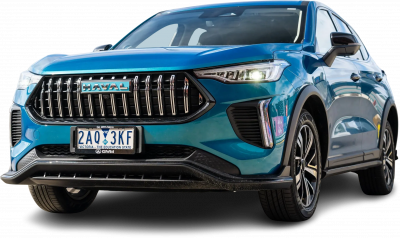
Haval Jolion

NX

X-Trail

Santa Fe

i30

Kona

Tucson
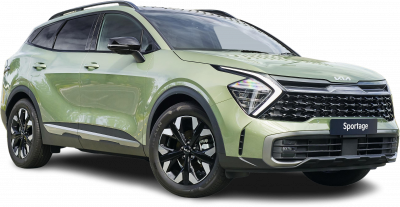
Sportage

Kluger

Camry
Can’t see the car you’re considering?
Is this the right car for you? Out experts buy or not guide.
The Toyota RAV4 Hybrid has long been the go-to choice for those seeking an economical mid-size SUV. However, heading into 2025, the competition has intensified significantly, with new hybrid rivals entering the market almost monthly.
While the RAV4 Hybrid still sets the benchmark in many respects, it's essential not to overlook other similarly sized and priced alternatives. For instance, the Honda CR-V, though slightly less efficient, features a petrol engine that starts more smoothly than the RAV4 Hybrid’s.
Additionally, the newly launched Hyundai Tucson Hybrid and Kia Sportage Hybrid present strong competition and are worth considering.
Within the RAV4 lineup, the flagship Edge variant no longer stands out significantly, as it's no longer available with the non-hybrid 2.5-litre four-cylinder petrol engine paired with an eight-speed automatic transmission. Its rugged exterior styling and distinctive orange interior accents may appeal to some, but they are not to everyone's taste, and it lacks some features found in the Cruiser variant.
Given this, the RAV4 Cruiser or XSE are the standout choices in the range, particularly when paired with the lighter and more efficient front-wheel-drive hybrid powertrain.
Where expert car reviews meet expert car buying – CarExpert gives you trusted advice, personalised service and real savings on your next new car.
The cheapest Toyota RAV4 is the GX that starts from $42,260.
The most expensive Toyota RAV4 is the Edge that starts from $58,360.
The best towing capacity of a Toyota RAV4 is 1500 kg offered by the following variants: GX, GXL, XSE, Cruiser and Edge.
The largest Toyota RAV4 is the Edge which measures 1865mm wide, 4615mm in length and sits 1690mm tall.
The most powerful Toyota RAV4 is the Edge which has 163kW of power from its 2.5L GASOLINE DIRECT INJECTION & MULTI-POINT engine.
The Toyota RAV4 is built in Japan and shipped to Australia.
The heaviest Toyota RAV4 is the GX which weighs 2230 kg (kerb weight).
The Toyota RAV4 uses unleaded.